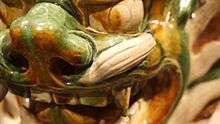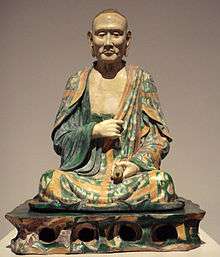Sancai
Sancai (Chinese: 三彩; pinyin: sāncǎi; literally: "three colours")[1] is a versatile type of decoration on Chinese pottery mainly using the three colors of brown, green, and a creamy off-white for decoration. It is particularly associated with the Tang Dynasty and its tomb figures.[2] Therefore, it is commonly referred to as Chinese: 唐三彩 Tang Sancai in Chinese.
It uses lead-glazed earthenware, and was much easier and therefore cheaper to make than Chinese porcelain, and suitable for making large figures, if necessary made up of several molded sections assembled after a first firing. Flatware dishes and other vessels were made in the technique as well as figures.
Technique

The body of sancai ceramics was made of white clay, coated with colored glaze, and fired at a temperature of 800 degrees Celsius. Sancai is a type of lead-glazed earthenware: lead oxide was the principal flux in the glaze, often mixed with quartz in the proportion of 3:1.[3] The polychrome effect was obtained by using as coloring agents copper (which turns green), iron (which turns brownish yellow), and less often manganese and cobalt (which turns blue).[3]
Sancai follows the development of green-glazed pottery dating back to the Han period (25-220 AD).[3]
Predecessors to the sancai style can also be seen in some Northern Qi (550-577) ceramic works. Northern Qi tombs have revealed some beautiful artifacts, such as porcellaneous ware with splashed green designs, previously thought to have been developed under the Tang dynasty.[4] Such a jar has been found in a Northern Qi tomb, which was closed in 576 AD, and is considered as a precursor of the Tang sancai style of ceramics.[5]
Development

The sancai technique dates back to the Tang Dynasty. However, the colors of the glazes used to decorate the wares of the Tang Dynasty generally were not limited to three in number. In the West, Tang sancai wares were sometimes referred to as egg-and-spinach by dealers, for their use of green, yellow, and white (though the latter of the two colors might be more properly described as amber and off-white or cream).
Sancai wares were northern wares made using white and buff-firing secondary kaolins and fire clays.[6] At kiln sites located at Tongchuan, Neiqui county in Hebei and Gongxian in Henan,[6] the clays used for burial wares were similar to those used by Tang potters. The burial wares were fired at a lower temperature than contemporaneous whitewares. Large figures made for grave goods in burials ("burial wares), such as the well-known representations of camels and horses, were cast in sections, in molds with the parts luted together using clay slip. In some cases, a degree of individuality was imparted to the assembled figurines by hand-carving.
Sancai continued to be produced in later periods, very often for large items made for temples. Sets of sancai luohan figures up to life-size were often displayed in special luohan halls in temples. Few of these that remained in place survived the Cultural Revolution. The Yixian glazed pottery luohans are a Liao dynasty set that is now distributed between various Western museums, and so very well known. Unusually, these were constructed around internal supporting iron bars. Pairs of large guardian figures flanking shrines were also made.
- Earthenware Tang dynasty tomb figure with sancai glaze, 7th-8th century
 Sogdian on a camel, in sancai, Tang dynasty tomb figure
Sogdian on a camel, in sancai, Tang dynasty tomb figure Green-glazed pottery dog, Eastern Han, 25-220 AD.
Green-glazed pottery dog, Eastern Han, 25-220 AD.- A Tang sancai footed jar
 One of the Yixian glazed pottery luohans, c. 1200
One of the Yixian glazed pottery luohans, c. 1200 A Tang sancai vase, 8th-9th century
A Tang sancai vase, 8th-9th century
Influences
Sancai travelled along the Silk Road, to be later extensively used in Syrian, Cypriot, and then Italian pottery from the 13th to the middle of the 15th century. Sancai also became a popular style in Japanese and other East Asian ceramic arts, such as Nagayo ware.
Modern reproduction trade
In the 1980s and early 1990s reproductions of Tang sancai pieces were sent by the Chinese government to foreign leaders as gifts, and became very popular within China. At one point there were more than 3,000 factories, mostly tiny and shabby, sprinkled around Luoyang City, cradle of the craft. They churned out shoddy Tang-style sancai pieces in vast numbers, until they began to undercut each other in a chaotic price war. With a glut in the market, many of their products ended up being hawked by street vendors.[7]
In recent years the market for original pieces has boomed, and their prices continue to soar sky high at auction houses around the world. This encourages the reproduction business, which has benefited from the development of new techniques. Some in the field can produce works that may fool even the most experienced eyes. Emboldened by the precision of forgery technology and lured by exorbitant profit, some sell pastiches as originals.[7]
References
- ↑ Morris Rossabi (28 November 2014). From Yuan to Modern China and Mongolia: The Writings of Morris Rossabi. BRILL. pp. 650–. ISBN 978-90-04-28529-3.
- ↑ "Chinese Porcelain Glossary: Sancai". Gotheborg.com. Retrieved 26 April 2015.
- 1 2 3 Shanghai Museum permanent exhibit.
- ↑ The arts of China by Michael Sullivan p.19ff
- ↑ Chinese glazes: their origins, chemistry, and recreation by Nigel Wood p.200
- 1 2 Wood, Nigel (1999). Chinese Glazes. A.C. Black, London. ISBN 0-7136-3837-0.
- 1 2 MENG, QINGHAI; ZHOU, YIXIANG (April 2010). "An Industry Loses Its Shine". China Today.
External links
![]() Media related to Sancai at Wikimedia Commons
Media related to Sancai at Wikimedia Commons
- A Handbook of Chinese Ceramics from The Metropolitan Museum of Art
